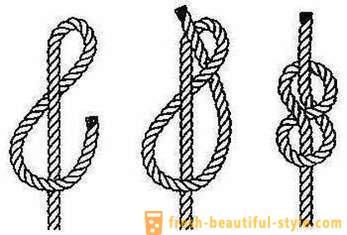Latching components: application. Node "eight"
Knitting skills nodes can be useful to fans of travel and tourism. Fishermen use them to mount the hooks, leads, and other elements of sinkers tackle. For climber inability to reliably fixed on a rock with a rope fraught fall, injury, death. Clothesline to perform its functions, it is also necessary to hang correctly, tighten, fix the ends. The locking unit "eight" fit in easily. Scheme and procedures just to remember. To learn how to knit, you need to spend just a few minutes.

Nodes: application features
In addition to the above cases, there are still many situations which can come in handy knitting skills. People do not even think about using this or that scheme (laces, tie, belt, ribbon, scarf). In each situation, the node has a different load and used for different purposes.
For example, to tie the rope ends for attachment to the child's sled can be different. Here fit and cow hitch, and the node "eight" at the end of the segment, previously threaded into an eyelet or opening in the frame. When you select either option is often not taken into account the compliance schemes and knitting rules. Users simply use the first suitable combination weave all, only be formed, in their view, a trusted site.
Meanwhile, the wrong choice can be a crucial moment to play a decisive role. All nodes somewhat weaken the overall strength of the rope or cable. But some of them have a smooth increase in breaking force during tightening, which is very important. At the same time, using a single circuit, it is possible to expect easy and quick assembly of unleashing even under heavy loads, and apply other, this is not possible.
locking assemblies
Wrong knotted cord in most cases does not have serious consequences. But the weakening of insurance in rock climbing or mountain climbing - it is a serious violation of safety regulations. When it is necessary to link two very thick rope or cable car stretches of hard (thin string guitar), there is no possibility tighten the knot. In this case, the usual scheme will not work - requires a special approach.
In practice, there is the sea more than 500 kinds of various types of rope connections, cables, ropes. The locking unit "eight" among them prominently. It is easily recognizable, relatively simple to perform and is the basis for many other, more complex schemes.
For reliable fixing his knitting skills, experts say, with enough training just five or six repetitions. As a result, at the arsenal will be another combination which can be used if necessary to connect the thick threads, and to form a node on a tattered dog leash.

assembly "eight": how to knit, Scheme
Another name - "Flemish loop". The main purpose and the most simple application - the formation of thickened (stopper) at the end of the cable segment, rope, fishing line, rope, rope. Advantages: not only weakens the overall strength, quick and easy fit, looks good. When sufficient material strength, if necessary "eight" node comparatively easily untangled even under heavy load on tightening.
End held under basic segment to fasten it, it is necessary free end (its length is chosen empirically) a forward wrap the cord in the opposite direction and then to stretch it in the resulting loop. Manner of work in humans may vary. Someone has formed a loop with holding the free end over the main segment, the other - from the bottom. By and large, it does not matter. The main thing that was the end through the loop. However, it should not start in the case of a simple tightening by the shortest path (only two options), and skipping over the formed cord ring. When you try to tighten some semblance of Eight should be formed.

Node "double eight": how to knit
It can be used when you need to make a greater thickening of the end of the segment. Another application - reliable loop formation. The procedure is the same as when knitting conventional "eight". The peculiarity lies in the fact that you are using double-cut, pre-bent and straightened loop along the main rope. Thus the loop can deduce at different distances from the node. This will depend on the particular situation.
Reliable "double figure of eight" to places in the hinge lug and can be tied into a single thickness. This may seem difficult at first, but after two or three repetitions of the process becomes clear. For this purpose, the free segment is chosen twice as long. First fit the usual "eight". Thereafter formed end is put into the eyelet or hole, wraps, and then passed along the first "eight". The cord should be in the opposite direction substantially parallel exactly repeating the initially formed curls. Then the assembly is tightened together with the basic segment.













































